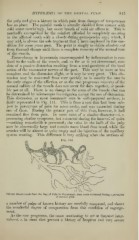Page 835 - My FlipBook
P. 835
—
HYPER.EMIA OF THE DENTAL PULP. — 845
the pulp and give a history in which pain from changes of temperature
has no place. The painful tooth is actually shielded from contact with
cold water unwittingly, but every breath of cold air affects it. This is
markedly exemplified by the comfort afforded by completely covering
in the affected tooth with a closely-fitting gutta-percha cap ; Mhich, I
may add, is almost the sole treatment that I have employed in this con-
dition for some years past. The point is simply to obtain absolute rest
from thermal change until there is complete recovery of the normal tone
of the vessels.
Tissue-change in hypersemia unaccompanied by inflammation is con-
fined to the walls of the vessels, and, so far as is yet determined, con-
sists of a passive distension resulting from a semi-paralysis of the local
action of the vaso-motor nerves of the part. This may be more or less
complete, and the distension slight, or it may be very great. This dis-
tension may be recovered from very quickly, as is usually the case in
the early stages of the affectiou, or as the case progresses recovery of the
normal calibre of the vessels does not occur for days together, or possi-
bly not at all. There is no change in the coats of the vessels that can
be determined by microscopic investigation except the one of distension.
This distension, as most commonly seen in well-prepared sections, is
fairly represented in Fig. 444. This is from a case that had been sub-
ject to paroxysms of pain for some weeks, and was extracted during
one of these. During the greater part of this time, however, it had
remained free from pain. In some cases of a similar character i. e.
presenting similar symptoms, but extracted during the interval of quiet
—nothing remarkable is presented ; the veins in the bulb of the pulp
may be abnormally large and contain more blood than usual, Avhile the
arteries will be almost or quite empty and the injection of the capillary
system wanting. This difference is very striking when the sections of
Fig. 444.
Dilated Blood-vessels from the Dental Pulp in Hypersemia, from tooth extracted during a paroxysm
of intense pain.
a mmiber of pulps of known history are carefully compared, and shoM's
the wonderful degree of recuperation from this condition of engorge-
ment.
As the case progresses, the cause continuing to act at frequent inter-
vals i. e. in cases that present a history of frequent and very severe
HYPER.EMIA OF THE DENTAL PULP. — 845
the pulp and give a history in which pain from changes of temperature
has no place. The painful tooth is actually shielded from contact with
cold water unwittingly, but every breath of cold air affects it. This is
markedly exemplified by the comfort afforded by completely covering
in the affected tooth with a closely-fitting gutta-percha cap ; Mhich, I
may add, is almost the sole treatment that I have employed in this con-
dition for some years past. The point is simply to obtain absolute rest
from thermal change until there is complete recovery of the normal tone
of the vessels.
Tissue-change in hypersemia unaccompanied by inflammation is con-
fined to the walls of the vessels, and, so far as is yet determined, con-
sists of a passive distension resulting from a semi-paralysis of the local
action of the vaso-motor nerves of the part. This may be more or less
complete, and the distension slight, or it may be very great. This dis-
tension may be recovered from very quickly, as is usually the case in
the early stages of the affectiou, or as the case progresses recovery of the
normal calibre of the vessels does not occur for days together, or possi-
bly not at all. There is no change in the coats of the vessels that can
be determined by microscopic investigation except the one of distension.
This distension, as most commonly seen in well-prepared sections, is
fairly represented in Fig. 444. This is from a case that had been sub-
ject to paroxysms of pain for some weeks, and was extracted during
one of these. During the greater part of this time, however, it had
remained free from pain. In some cases of a similar character i. e.
presenting similar symptoms, but extracted during the interval of quiet
—nothing remarkable is presented ; the veins in the bulb of the pulp
may be abnormally large and contain more blood than usual, Avhile the
arteries will be almost or quite empty and the injection of the capillary
system wanting. This difference is very striking when the sections of
Fig. 444.
Dilated Blood-vessels from the Dental Pulp in Hypersemia, from tooth extracted during a paroxysm
of intense pain.
a mmiber of pulps of known history are carefully compared, and shoM's
the wonderful degree of recuperation from this condition of engorge-
ment.
As the case progresses, the cause continuing to act at frequent inter-
vals i. e. in cases that present a history of frequent and very severe


